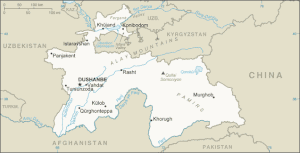Заминҳои минборони сарҳади Ӯзбакистон-Тоҷикистон
Ин мақола ё фасл тарҷумаи нопурра аз забони хориҷаро дорад. |
Заминҳои минборони сарҳади Ӯзбекистон-Тоҷикистон

The Uzbek-Tajikistan border minefields are the result of Uzbekistan's unilateral decision to indiscriminately mine rural areas along its border region with Tajikistan. Aimed at hindering drug trafficking and cross-border infiltrations of terrorists of the Islamic Movement of Uzbekistan in the area, it is Tajik civilians of the border areas who suffer, with most of the victims being women and children gathering firewood or tending their cattle near the border. Almost all who have survived have been maimed for life. Uzbekistan asserts that it is placing mines in its territory, but so far not all the boundaries between Uzbekistan and Tajikistan have been delineated.[1] By 2004 Tajikistan and Uzbekistan had settled almost 86% of their 1,283-km border dispute following the collapse of the Soviet Union in 1991.[2]
Opinions on the minefields
[вироиш | вироиши манбаъ] Кумитаи байналмиллалии Салиби Сурх - The former head of the International Committee of the Red Cross in Tajikistan, George Gunz, said "Any government taking such steps must inform the population of mine locations and types of mines." He said that all international humanitarian norms were being violated so long as the mine locations were not marked, posing a constant threat to the lives of civilians living in border areas. Gunz said that such incidents would continue until governments agreed to sign the Ottawa Convention prohibiting the use of antipersonnel mines.[1]
Кумитаи байналмиллалии Салиби Сурх - The former head of the International Committee of the Red Cross in Tajikistan, George Gunz, said "Any government taking such steps must inform the population of mine locations and types of mines." He said that all international humanitarian norms were being violated so long as the mine locations were not marked, posing a constant threat to the lives of civilians living in border areas. Gunz said that such incidents would continue until governments agreed to sign the Ottawa Convention prohibiting the use of antipersonnel mines.[1]
 Uzbekistan's defence minister, Qodyr Pulatov, has defended his country's actions: "All mines laid have been marked with special plates warning of danger," (an assertion Tajik authorities in Dushanbe dismiss after recent official missions to the area failed to locate any such notices).[1]
Uzbekistan's defence minister, Qodyr Pulatov, has defended his country's actions: "All mines laid have been marked with special plates warning of danger," (an assertion Tajik authorities in Dushanbe dismiss after recent official missions to the area failed to locate any such notices).[1]
See also
[вироиш | вироиши манбаъ]References
[вироиш | вироиши манбаъ]- ↑ 1.0 1.1 1.2 Tajikistan: Victims of Uzbek land mines increasing. Integrated Regional Information Networks (May 07, 2001). 7 июни 2007 санҷида шуд. Баргирифта аз сарчашмаи аввал 27 сентябри 2007.
- ↑ Tajikistan: Focus on demining efforts. Integrated Regional Information Networks (July 13, 2004). 7 июни 2007 санҷида шуд. Баргирифта аз сарчашмаи аввал 6 августи 2007.
